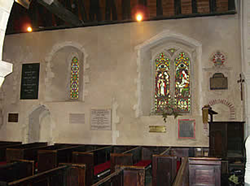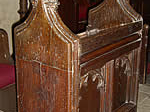Nave, Pulpit and Font
The Nave
The nave, of three bays, is Norman with Early English additions and later medieval alterations. Surviving features from the Norman period include the north-east tufa quoin, and part of one rere-arch.
South Nave Arcade
The south nave arcade, of three bays and with slightly pointed Early English arches, stands on square piers. (for the fifteenth century alterations to the east pier and arch to accommodate the Rood loft.
The Pulpit
Historically, the first pulpit of record at Doddington was Elizabethan, and as such older than many in Kent churches. It was already made, and probably fairly new in 1585, when the churchwardens reported of the church that "All is well, except a cloth and cushion to lay on the pulpit". In the 1960's Pevsner identified the Doddington pulpit as "Jacobean" relying, as he largely did both for church furnishings and fabric, only upon physical evidence for dating. It must be said that there was little stylistic change between late Elizabethan and early Jacobean woodwork and that most Kent pulpits were indeed Jacobean because of the 1603 directive to churchwardens to provide in every church "a comely and decent pulpit". The present pulpit at Doddington, however, may not be the same one referred to by the Elizabethan churchwardens. It shows no signs of the distressing arising from centuries of wear, and the carving, though fine, is sharp. Possibly it is a good, but modern copy.
The Reading Desk
The reading desk has notable poppyheads that, however, have lost their finials.
The Font
The plain hexagonal stone font, unadorned by carving, stands two steps above the nave floor and near the entrance to the present tower. Since medieval fonts were usually near doors (signifying that baptism is the entrance to the Church of Christ) this is probably not its original position.
The sharpness of the stone cutting suggests a modern date (made for the 1855 restoration?) but the wooden font cover, topped by a gilded wooden orb, may well be older.



